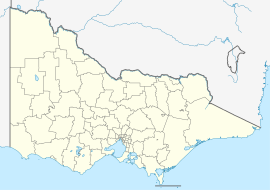
Back بنديجو Arabic بنديجو ARZ Бендыга Byelorussian Бендиго Bulgarian Bendigo Catalan Bendigo CEB بێندیگۆ CKB Bendigo Czech Bendigo Welsh Bendigo German
| Bendigo Victoria | |||||||||
|---|---|---|---|---|---|---|---|---|---|
 Bendigo city centre | |||||||||
| Coordinates | 36°45′0″S 144°16′0″E / 36.75000°S 144.26667°E | ||||||||
| Population | 103,034 (2021)[1] (19th) | ||||||||
| • Density | 358.50/km2 (928.52/sq mi) | ||||||||
| Established | 1851 | ||||||||
| Postcode(s) | 3550[2] | ||||||||
| Elevation | 213 m (699 ft) | ||||||||
| Area | 287.4 km2 (111.0 sq mi)[3] (2016 urban) | ||||||||
| Time zone | AEST (UTC+10) | ||||||||
| • Summer (DST) | AEST (UTC+11) | ||||||||
| Location | |||||||||
| LGA(s) | City of Greater Bendigo | ||||||||
| Region | Loddon Mallee | ||||||||
| County | Bendigo | ||||||||
| State electorate(s) | |||||||||
| Federal division(s) | Bendigo | ||||||||
| |||||||||
Bendigo (/ˈbɛndɪɡoʊ/ BEN-dig-oh) is a city in Victoria, Australia, located in the Bendigo Valley near the geographical centre of the state[4] and approximately 150 kilometres (93 mi) north-west of Melbourne, the state capital.
As of 2022, Bendigo has a population of 103,818 making it Australia's 19th-largest city by population.[5] Bendigo is the fourth-largest inland city in Australia and the fourth-most populous city in Victoria.
Bendigo is administered by the City of Greater Bendigo, formerly the City of Bendigo. The council area encompasses roughly 3,000 square kilometres,[6] the city is surrounded by smaller towns such as Castlemaine and Heathcote.
The traditional owners of the area are the Dja Dja Wurrung (Djaara) people.[7] The discovery of gold on Bendigo Creek in 1851 transformed the area from a sheep station into one of colonial Australia's largest boomtowns. News of the finds intensified the Victorian gold rush, bringing an influx of migrants from around the world, particularly Europe and China. Bendigo became eastern Australia's largest 19th-century gold-mining economy, and the wealth generated during this period is reflected today in the city's Victorian architectural heritage. From 1853 until 1891, Bendigo was officially named Sandhurst.
Bendigo's boom period lasted until the early 20th century and after a temporary decline in population and employment, renewed growth occurred from the 1930s as the city consolidated as a manufacturing and regional service centre. Although gold mining continues, recent population growth has been most heavily concentrated in suburban areas. With the completion of the Calder Freeway linking Melbourne and Bendigo in 2009, and the region's proximity to Melbourne, Bendigo has become one of the fastest-growing regional centres in Victoria.[8]
- ^ "2021 Bendigo, Census All persons QuickStats". Australian Bureau of Statistics. Retrieved 28 June 2022.
- ^ "3550 Postcode". Australia Post. Australia Post. Retrieved 2 April 2024.
- ^ "2016 Census Community Profiles: Bendigo". ABS Census. Australian Bureau of Statistics. Retrieved 26 October 2017.
- ^ Plaque to mark Exact Centre of Victoria - 12/10/2006 City of Greater Bendigo
- ^ Statistics. "Population estimates by LGA, Significant Urban Area, Remoteness Area and electoral division, 2001 to 2022". abs.gov.au. Australian Bureau of Statistics. Retrieved 23 January 2024.
- ^ "Our region | City of Greater Bendigo". www.bendigo.vic.gov.au. Retrieved 16 December 2023.
- ^ "Djaara (Dja Dja Wurrung Clans Aboriginal Corporation)". Retrieved 1 June 2021.
- ^ Welcome to the City of Greater Bendigo population forecasts City of Greater Bendigo
© MMXXIII Rich X Search. We shall prevail. All rights reserved. Rich X Search
